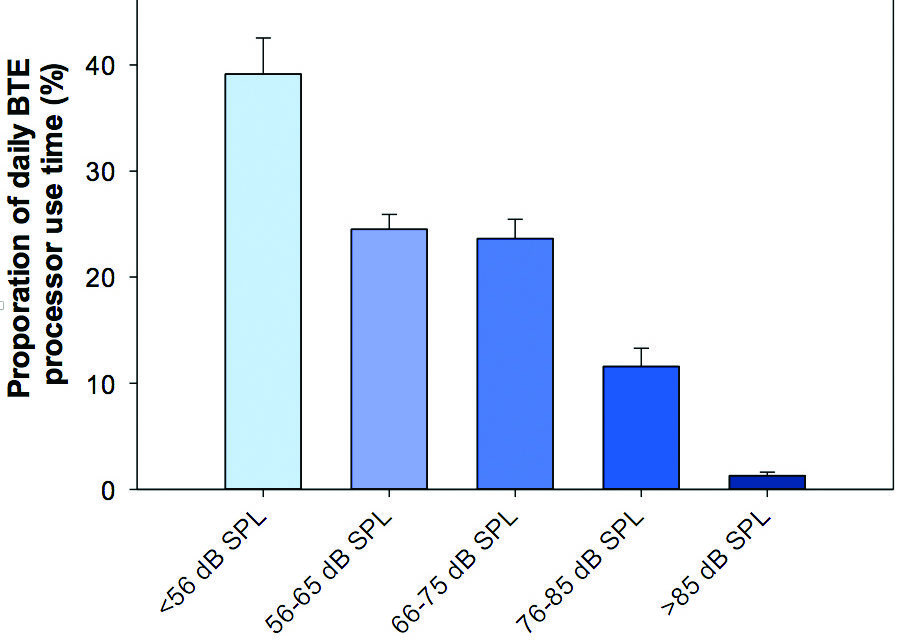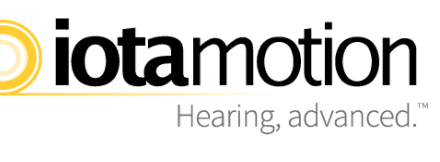Tech Topic | March 2020 Hearing Review
This study found that using datalogging as a tool for counseling parents about their child’s use of and experience with the cochlear implant helps increase wear time, proactively identify technical issues for troubleshooting, and gain new insights into the child’s listening environment and needs. This type of counseling not only provides an objective basis to encourage consistent device use, but also serves as a tool to motivate, reward, or validate parental support of their children’s listening needs.
By Chrisanda Sanchez, AuD, Ivette Cejas, PhD, and Smita Agrawal, PhD
Today’s cochlear implants (CIs) log data that provide insight into the recipient’s everyday environment and use time. In the case of children, these factors can play an important role in speech and language development. The datalogging functionality can be used to objectively measure and counsel families regarding their child’s device use.1,2 Since this feature is relatively new to CIs, little is known about its utility in pediatric CI users.
Previous literature has established that significant benefit is obtained from early cochlear implantation, including improvements in speech and language outcomes, reading, and cognitive development in children.3-10 However, consistent device use is imperative to achieve and maintain these results.11,12
In recent years, cochlear implant manufacturers have introduced datalogging that provides objective reports of hourly device use (measured as an average per day), time in different types of listening environments, and use of accessories. Datalogging can also identify when the headpiece magnet is not making a connection with the internal magnet. This may be due to the device falling off or being taken off the head, but can also be a reflection of an intermittency in the equipment. These events are identified as “unlocked” events in this study’s datalogging report through the Advanced Bionics software. While several studies have documented that consistent CI use is observed in many children, averaging 9 hours/day,11 few studies have compared these datalogging events to parental report.
The present study investigated the relationship between parent reports and the information obtained from the datalogging feature in Naida CI Q series sound processors.
Methods
A total of 8 children (4 females and 4 males) between 26 months and 65 months of age (ie, about 2-4.5 years) were enrolled at the Ear Institute at the University of Miami and participated in two study phases. All children had at least 6 months of experience with the AB Naida CI sound processor prior to study recruitment. Seven were bilaterally implanted and one used the bimodal listening configuration (ie, cochlear implant with a hearing aid in the contralateral ear). Seven children were enrolled in weekly auditory verbal therapy and one in monthly auditory verbal therapy.
Parents completed a daily online survey during a 2 week period (Figure 1). The survey aimed to capture the parents’ perspective of their child’s CI usage, which included daily use duration, processor wearing configuration, program use, use of streaming devices, listening environment types (noise, quiet, music) and settings (eg, recreational, instructional, meal time with small or big groups, car, etc) and duration of exposure to these situations.
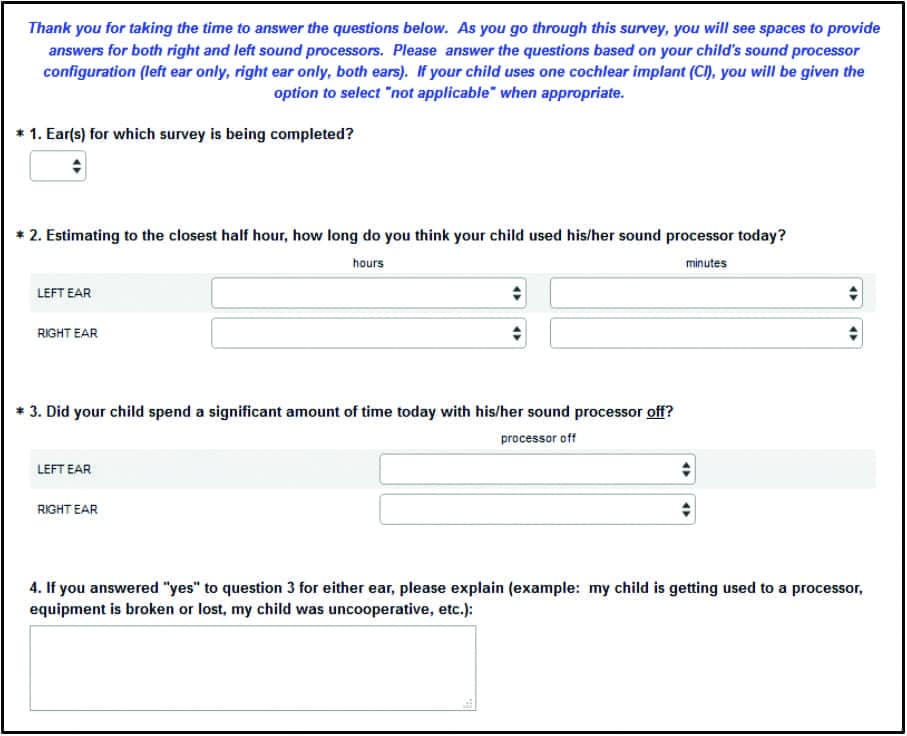
Additionally, families made multiple clinic visits over the study duration (5 visits over 6 weeks [Subjects 1 to 3]; 6 visits over 7 weeks [Subjects 4 to 8]). At each visit, the logged data were extracted from the Naida CI sound processors and compared to the weekly online survey data, as available. This information was used to counsel families on wear time optimization and listening environment experiences, and to determine if any changes in wear time and/or listening environments occurred following counseling sessions.
Results
Figure 2 shows the sound environment datalogging results from the 8 children. On average, the children spent a majority of their time in a “speech in quiet” setting (74.22%). These findings are aligned with parental observations as captured by the weekly online survey results (5.63 hours daily average). The findings are also consistent with the literature on adult hearing aid users assessing exposure in varying noise environments, which indicated adults were infrequently in noisy environments (ie, negative SNRs or close to 0 dB).13

Total daily use durations as assessed from datalogs and daily surveys were also found to be in agreement (9.56 hours and 9.04 hours respectively). These findings are in contrast with those from Walker et al,14 who found that 84% of parents overestimated their child’s hearing aid use time. Figure 3 summarizes online survey and datalogging results regarding average daily use duration, and time spent in “speech-in-quiet” and “speech-in-noise” environments.
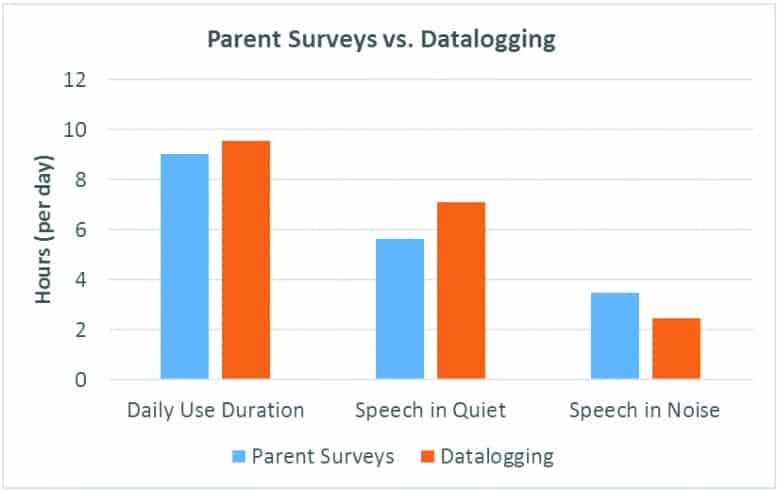
Figure 4 shows the average levels of sound environments experienced by each child in a daily basis as measured by the BTE’s datalogging. Children spent 39.15% of their BTE use time in sound levels <56 dB SPL. As a comparison, a datalogging study conducted by Banerjee15 in 10 adult hearing aid users found 50% time spent in environments ≤50 dB SPL.
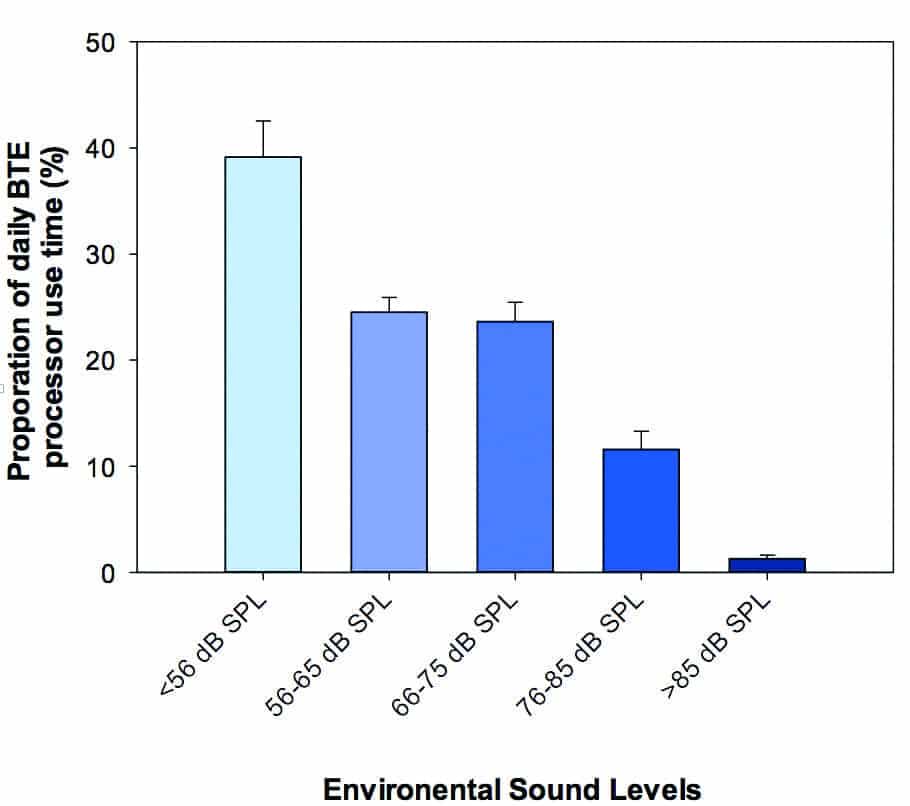
Following counseling sessions, overall improvements were noted in daily usage and number of unlocked events. Duration of use appeared to increase in 4 of 8 subjects, and unlocked events decreased in 5 of 8 subjects. Battery type and slot usage features correlated with parental reports on the survey.
Clinical Implications and Conclusion
During this study, datalogging provided a series of clinically meaningful insights. Discussion with parents regarding use trends in the datalog likely contributed to increased wear time. Additionally, logged streaming time was useful when counseling about the use of wireless accessories, such as the ComPilot or FM system. It was also a useful point of reference when encouraging patients to try new accessories.
For clinicians, access to datalogging information is a helpful tool for troubleshooting. For example, in our study one patient’s logged data showed an abnormally high number of unlocked events (355), which prompted diagnosis of a cable intermittency that was previously unreported. To troubleshoot a high incidence of unlocked events, it is also important to consider non-hardware sources of occurrences. We find it helpful to ask families more detailed questions related to when the device is and is not being used, whether the unlocked events only happen in certain environments, and whether the events are a reaction to when the child is upset or non-compliant. This will help determine whether programming needs to be adjusted or whether further counseling is needed to manage these behaviors.
Overall, families reported satisfaction in knowing that datalogging could identify intermittencies in equipment. Incorporating datalogging as a counseling tool by showing families percentages and overall wear-time appeared to be a motivating factor for families to continue their work in consistent use and device retention. Across all the data reviewed during these counseling sessions, families reported that they found the number of unlocked events and percentage of time in different listening environments to be the most helpful.
The inclusion of a questionnaire to assess parent perception was a unique addition to the clinic visits. Over time, parents who participated in this study were observed to be more realistic with their estimates on device use. Parents were more inquisitive about their children’s listening environments and this, in turn, made them more engaged and invested in committing to consistent use. The survey responses also highlighted the role of other significant individuals, such as grandparents, therapists, and teachers, and their involvement in the child’s consistent CI use and the need for making them more aware and engaged.
We conclude that datalogging can be a valuable input to audiological counseling in cochlear implantation that positively influences daily device usage and, in turn, positively impacts patient outcomes. This type of counseling not only provides an objective basis to encourage consistent device use, but also serves as a tool to either motivate, reward, or validate parental support of their children’s listening needs.
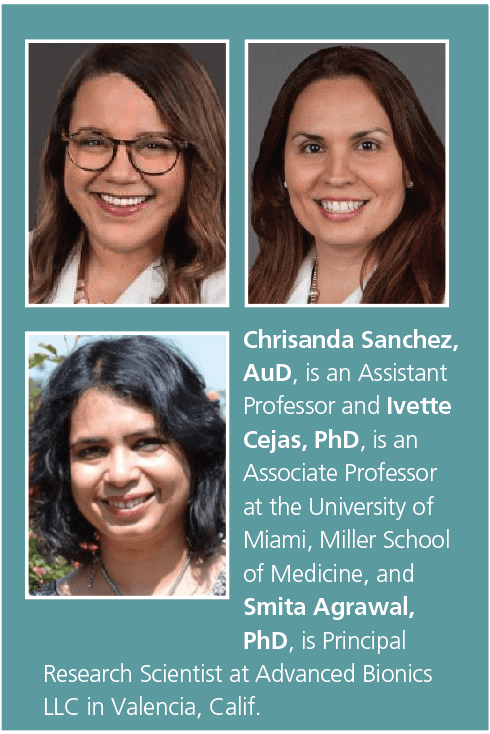
Correspondence can be addressed to Dr Agrawal at: [email protected].
Original citation for this article: Sanchez C, Cejas I, Agrawal S. Comparing parent perceptions to datalogging information in pediatric cochlear implant users. Hearing Review. 2020;27(3):20-24.
References
1. Muñoz K, Preston E, Hicken S. Pediatric hearing aid use: How can audiologists support parents to increase consistency? J Am Acad Audiol.2014;25(4):380-387.
2. Laplante-Lévesque A, Nielsen C, Jensen LD, Naylor G. Patterns of hearing aid usage predict hearing aid use amount (data logged and self-reported) and overreport. J Am Acad Audiol. 2014;25(2):187-198.
3. Hess CL, Misurelli SM, Litovsky RY. Spatial release from masking in 2-year-olds with normal hearing and with bilateral cochlear implants. Trends Hear. 2018;22. https://doi.org/10.1177/2331216518775567.
4. Monteiro CG, Cordeiro AADA, Da Silva HJ, De Queiroga BAM. Children’s language development after cochlear implantation: A literature review. CoDAS. 2016;28(3):319-325. https://doi.org/10.1590/2317-1782/20162015151 .
5. Bharadwaj SV, Maricle D, Green L, Allman T. Working memory, short-term memory and reading proficiency in school-age children with cochlear implants. Int J Pediatr Otorhinolaryngol. 2015;79(10):1647-1653.
6. Litovsky RY, Goupell MJ, Godar S, et al. Studies on bilateral cochlear implants at the University of Wisconsin’s Binaural Hearing and Speech Laboratory. J Am Acad Audiol. 2012;23(6):476-494.
7. Niparko JK, Tobey EA, Thal DJ, et al. Spoken language development in children following cochlear implantation. JAMA. 2010;303(15):1498-1506.
8. Hay-McCutcheon MJ, Kirk KI, Henning SC, Gao S, Qi R. Using early language outcomes to predict later language ability in children with cochlear implants. Audiol Neurootol.2008;13:370-378.
9. Eisenberg LS, Johnson KC, Martinez AS, et al. Speech recognition at 1-year follow-up in the childhood development after cochlear implantation study: Methods and preliminary findings. Audiol Neurootol. 2006;11:259–268.
10. Kirk KI, Ying E, Miyamoto RT, O’Neill T, Lento CL, Fears B. Effects of age at implantation in young children. Ann Otol Rhinol Laryngol. 2002;111(5):69-73.
11. Easwar V, Sanfilippo J, Papsin B, Gordon K. Impact of consistency in daily device use on speech perception abilities in children with cochlear implants: Datalogging evidence. J Am Acad Audiol. 2018;29(9):835-846.
12. Lee H-J, Smieja D, Polonenko M, Cushing SL, Papsin BC, Gordon KA. The importance of consistent cochlear implant use on cortical plasticity in children with single sided deafness. Paper presented at: Conference on Implantable Auditory Prostheses (CIAP) 2019; July 14-19, 2019; Lake Tahoe, CA.
13. Smeds K, Wolters F, Rung M. Estimation of signal-to-noise ratios in realistic sound scenarios. J Am Acad Audiol.2015;26(2):183-196.
14. Walker EA, Spratford M, Moeller MP, et al. Predictors of hearing aid use time in children with mild-to-severe hearing loss. Lang Speech Hear Serv Sch. 2013;44(1):73-88.
15. Banerjee S. Hearing aids in the real world: Typical automatic behavior of expansion, directionality, and noise management. J Am Acad Audiol. 2011;22(1):34-48.

